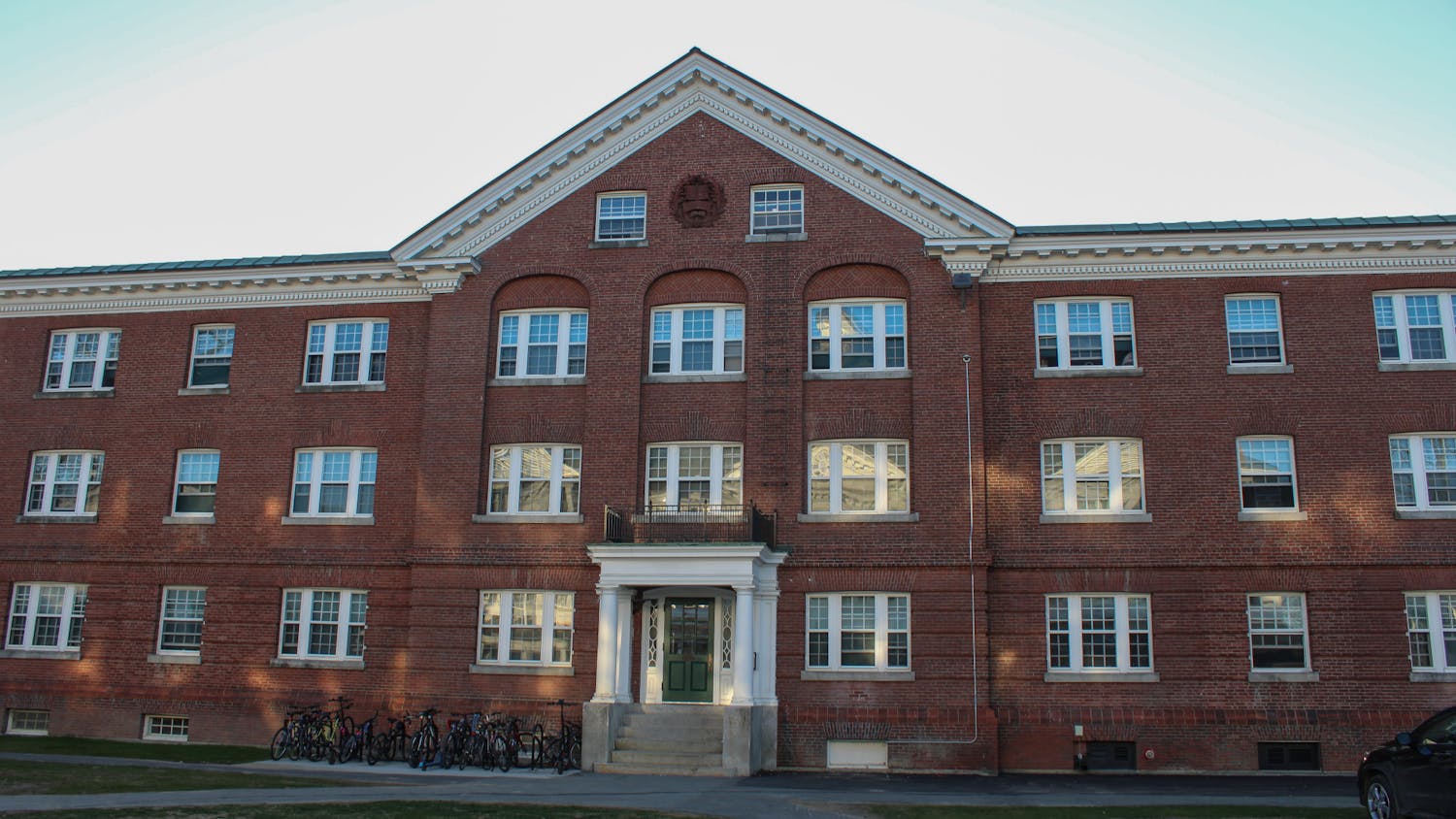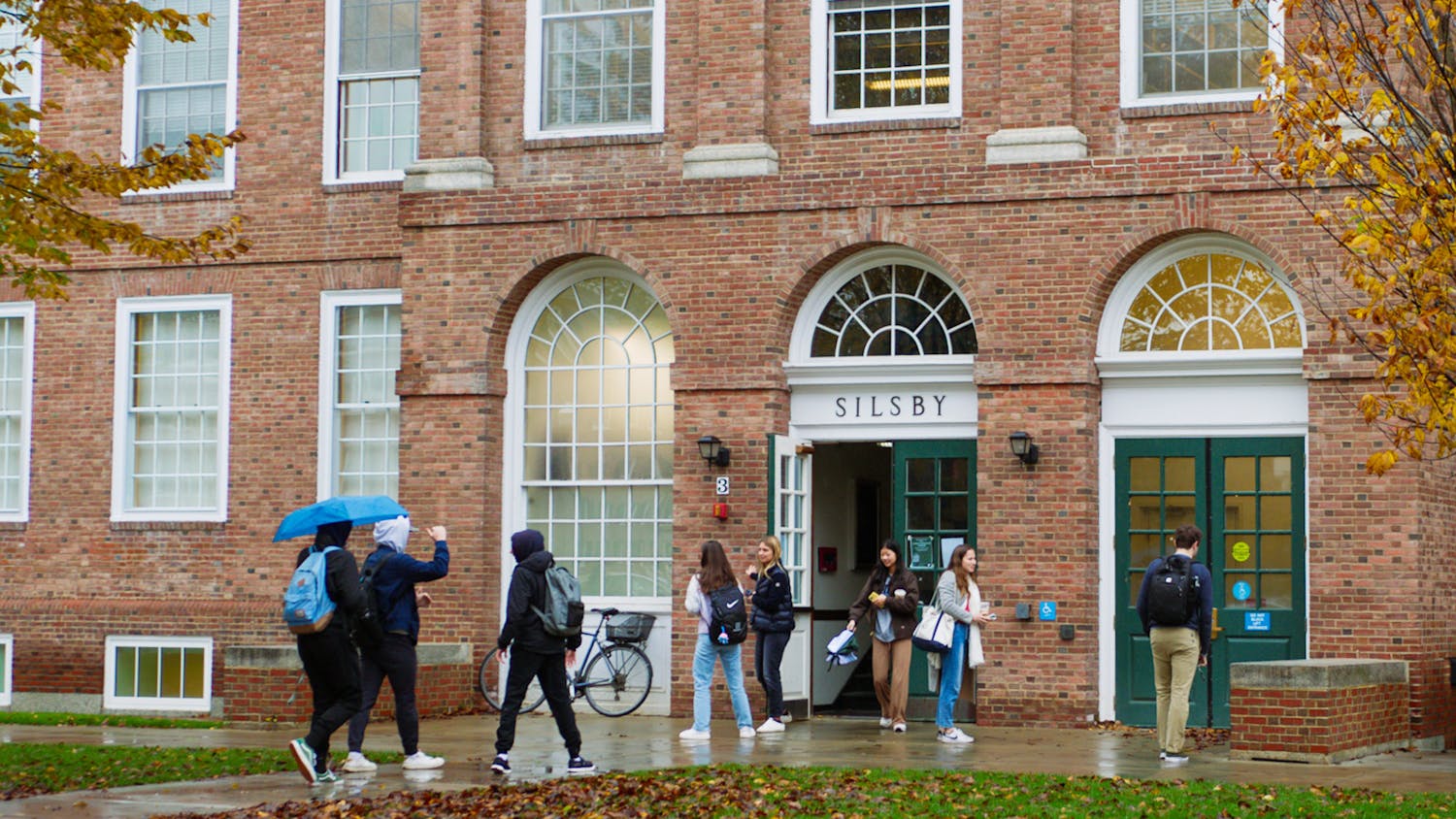Bartlett Hall
Nicole Simineri ’17
I’m an AMES major, which means that I spend a lot of time in Bartlett Hall, the red brick structure at the end of the long line of buildings that characterize College Street. The building stands out in contrast to the white simplicity of Dartmouth Hall and its neighbors. Like my major, this building is relatively unknown among the Dartmouth community. Yet the first time I came to the College, this castle-like building that looked so out of place immediately caught my attention. Whatever it was, it was beautiful, and I wanted to know more.
When I began taking AMES classes, I was happy to discover that the inside of Bartlett was just as odd as the outside. Huge, old wooden doors lead to the short hallway that branches off into two cozy, yet distinct, classrooms and into a bright, warm common area. It’s surrounded by faculty offices, the doors which are almost always open. The widest staircase — which also has the shortest stairs — leads upward to a relatively unknown, but impeccably clean and spacious study room, where I have wrapped up many homework assignments and Japanese exams. Even the bathroom is unlike any other on campus, with its thick wooden door that constantly jams and the huge stained glass window that comprises most of the bathroom wall. Because of how familiar I have become with its strange quirks — jamming door and all — Bartlett Hall has gone from being an unnamed building that I had to look up on a map to my home.
Panarchy
Sam Van Wetter ’16
I was speaking with a small Russian woman in Collis recently. She has a granddaughter who is a member of the Class of 2018, and the woman was delighting in interviewing various students to learn the wild variety of Dartmouth paths. When I told her I live in Panarchy, however, her face crinkled. “Sounds dangerous. Is it very dangerous?” I told her no, of course not — the fire department has ensured it’s livable, and don’t believe the hype, for we were never condemned to start with.
“I mean the concept,” she insisted. “Panarchy. Anarchy everywhere. No order for everyone, it sounds like.”
I explained that, no, the word doesn’t really mean anything. An early ‘90s Phi Psi probably found the name vaguely edgy and suitable for the newly non-Greek, totally inclusive space. But that woman got me thinking. What’s in a name? What does it mean to be part panda, part anarchist? Is it the very word that allows for a Dartmouth existence more free and undefined? Does this arbitrarily chosen term coined by an irrelevant Belgian botanist define our haus or has our haus become a definition of its own?
To me, Panarchy is a permission. It’s the mischievousness of the Greek faun and the irreverent ideal of lawlessness. It’s the cooking tool, the hunt for gold, the assurance that it will all pan out. It’s an ark, a vessel in Dartmouth’s often rough seas.
It’s the second-oldest building on campus, built circa 1835 for Hanover’s town doctor. It’s a singular experience to live in a haus that has evolved so much, having been home to a family, a fraternity, a co-ed and a host of wall-dwelling squirrels throughout.
Reminders of its history are everywhere, from a thin strip of original jungle-themed wallpaper uncovered in recent renovations to occasional visitations from our resident ghost, Emily. Still, the past is a foundation — not a limitation — for the future. We host rave to honor the countless souls who have walked the floors, not to spite them. Panarchy is a place to cook, cry, read, sleep, dance, dance!, sing, shout, hold and be held. The word, like the haus we occupy, is but a frame within which we can be all and anything we want. The big secret is that we are all Panarchists, even you — and especially if you don’t know it yet.
“Yes,” the sweet old lady repeated. “It’s very dangerous.”
The Tower Room
Caroline Hansen ’17
When thinking about my favorite place at Dartmouth my mind immediately went to the Tower Room. What’s my favorite part of the Tower Room, you ask? The views of the Green? The austere portraits of Dartmouth men long past? The green velvet interior? The petite, dollhouse staircases that are — for reasons unknown to me — forbidden for students to use to access the second level? Despite the guy next to you wearing Beats by Dre and chewing beef jerky, there’s something about the Tower Room that makes you feel like you’re in a period piece.
It’s a room full of surprises. Did you know it holds a copy of a portrait of William Legge, Second Earl of Dartmouth? Did you know that the only person still there with you at 2 a.m. on a Saturday night your freshman fall was actually sleeping the whole time because it’s not lit at night? People hate when you talk in the Tower Room, or when you spill Cocoa Krispies all over their problem set — also something I did freshman fall. Being in the Tower Room is rewarding, beautiful and reminiscent of a Dartmouth long, long ago. Just don’t stay past sunset.
Foley House
Nicholas Thyr ’17
People, I have found, do not quite understand the appeal of Foley House.
“Wow,” they say. “Isn’t that a really long walk?” Or, “Wait — you have to cook? A meal? For 10 people? I could never do that.”
Both of those things are true. Foley is a long way from campus (turn right at the gas station, walk three blocks). Yes, it is required that each member cook for the other members roughly once every two weeks — we’re technically a living learning community, and our “focus” is, vaguely, cooking. But that’s not what the house is “about.”
What has stuck with me most about my time at Foley House are the conversations I have had, both one-on-one and around the dinner table, ranging over innumerable topics from the agenda of Pope Francis to historical patterns in shark attacks off the coast of Australia. The discussions have spilled on and on, each one of us knowing we have some pressing assignment to churn through, but also knowing, just the same, that no assignment is worth breaking the conversation off. More than just the conversations we have, the allure of Foley is watching the small community of nine people gel over the course of the term, from the initial awkward encounters at the start of the term (“Hi.” “Hi.” “What’s your major?”) to the freedom at the end of the term to be truthful, silly, foul-mouthed — to be ourselves.
Quite simply, living at Foley has been the best decision I have made at Dartmouth.
8 School Street
Nkenna Ibeakanma ’16
I came to Dartmouth fresh off a gap year, unsure of my ability to thrive in an academic setting again and uneasy about being in a class of younger people. I was downright scared after nine months of notifications from the Class of 2016 Facebook group — but I was excited. I craved the difference my new home would bring.
A week into Dartmouth, I believed I was a failure. I hadn’t gotten into my first choice a capella group. I didn’t know I was to become a member of a group that would shape my life in such a profound way — it is almost ridiculous to believe an a capella group could have such deep ramifications.
When I think of the my freshmen year in the Rockapellas I think of the members of the Class of 2013, most of whom lived together off-campus. The group was my home. It was security and comfort encapsulated in a unit of diverse women who taught me so much about the complexities of womanhood — just by being themselves. It was the insecurity and discomfort of unlearning obstinate ideas that I held true. It was where I learned to deal with my feelings instead of putting them in a nicely sealed envelope at the back of my brain. I think about the Rocks, and I think of rehearsals in the front room and sneaking through the back door into my friend’s room. I think of 8 School Street.
The once-crumbling house isn’t technically a Dartmouth space, but my time at Dartmouth would be different without it. The home at 8 School Street reminds me of the beautiful whirlwind of being new here, of being too caught up in transformation to be held down by the things about this place that make me sad. Even now, post-rose-tinted Ray-Bans, the house makes me think of the woman I’ve become. I think of how lucky I was to have thoughtful women who loved me right from the beginning, and I feel oh-so-lucky that I failed that one time.
The Graveyard
Aaron Pellowski ’15
Call it macabre, but one of my favorite places to chill on campus is the graveyard behind FoCo. I have always had a queer affinity for graveyards and cemeteries. (Don’t ask me to tell you what the difference is between the two. I don’t know!) In elementary school, I built a graveyard behind my garage out of stakes and mossy stones for all my imaginary friends. If you think an imaginary friend is already sufficiently abstract for an eleven-year-old, imagine how precocious I must have been, sitting cross-legged in this dismal arena, fancying that I could commune with the ghosts of my dead imaginary friends!
Anyway, I was enormously pleased as a freshman to discover our graveyard, just a five-minute putter from Russell Sage, brimming with stones, tombs, tables and more. The little trips I’d take to the graveyard siphoned off hours of my time, fall, winter and spring. I read the names inscribed, the names of men and their nameless wives, laid to rest and decomposing in series with their memories, already forgotten to time before I was even born. I found relics of initiation rites of senior societies and Greek houses, including mannequins, tea-lights and low-grade wine.
The thing I really treasure about graveyards, though, has more to do with space and atmosphere. You can cloister yourself in your room, or find a hidden crevice of the library in which to study and ponder and pout, but only in a graveyard can you feel the liberating breath of solitary experience while still in the open air. The graveyard is a sacred space. You can go there to sing at the face of God and not fear onlookers. You can just sit, uninterrupted, and imagine all the corpses, converted to earth and reconverted to vegetation, that have found new life in the silent growth around you. The same human carbon that flows in circles through my blood is circulated up the xylum of the pines, from the center of the earth, starward. That’s what’s neat about graveyards. Check one out.



